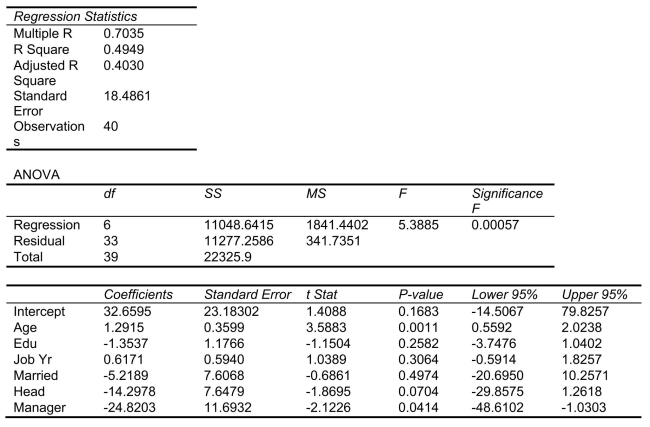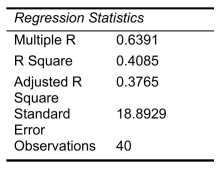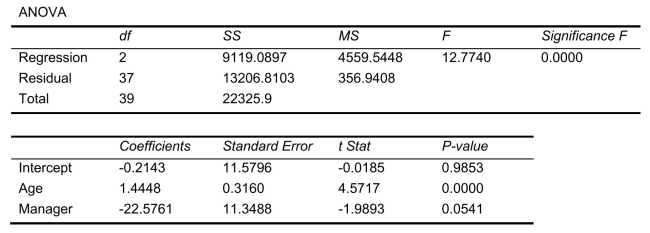SCENARIO 18-10 Given below are results from the regression analysis where the dependent variable is the number of weeks a worker is unemployed due to a layoff (Unemploy)and the independent variables are the age of the worker (Age), the number of years of education received (Edu), the number of years at the previous job (Job Yr), a dummy variable for marital status (Married: 1 = married, 0 = otherwise), a dummy variable for head of household (Head: 1 = yes, 0 = no)and a dummy variable for management position (Manager: 1 = yes, 0 = no).We shall call this Model 1.The coefficient of partial determination  of each of the 6 predictors are, respectively, 0.2807, 0.0386, 0.0317, 0.0141, 0.0958, and 0.1201.
of each of the 6 predictors are, respectively, 0.2807, 0.0386, 0.0317, 0.0141, 0.0958, and 0.1201.  Model 2 is the regression analysis where the dependent variable is Unemploy and the independent variables are Age and Manager.The results of the regression analysis are given below:
Model 2 is the regression analysis where the dependent variable is Unemploy and the independent variables are Age and Manager.The results of the regression analysis are given below: 

-Referring to Scenario 18-10 Model 1, the alternative hypothesis  : At least one of
: At least one of  for j = 1, 2, 3, 4, 5, 6 implies that the number of weeks a worker is unemployed due to a layoff is affected by at least one of the explanatory variables.
for j = 1, 2, 3, 4, 5, 6 implies that the number of weeks a worker is unemployed due to a layoff is affected by at least one of the explanatory variables.
Definitions:
Real GDP
The measure of a country's economic output adjusted for price changes (inflation or deflation), providing a more accurate reflection of an economy's size and growth.
Price Level
The average of the current prices of goods and services in an economy, which can influence purchasing power and inflation.
Inflation
The rate at which the general level of prices for goods and services is rising, and subsequently, purchasing power is falling. Central banks attempt to limit inflation, and avoid deflation, in order to keep the economy running smoothly.
Multiple Counting
The erroneous practice of counting the same item more than once when calculating economic data, such as in measuring GDP.
Q13: Referring to Scenario 20-1, if the probability
Q19: Referring to Scenario 16-13, what is your
Q21: Referring to Scenario 20-1, if the probability
Q44: Referring to Scenario 19-7, an R chart
Q85: Which of the following terms describes the
Q91: Referring to Scenario 18-10 Model 1, _
Q108: Removal of uncertainty from a decision-making problem
Q123: Referring to Scenario 20-6, the optimal strategy
Q133: Referring to Scenario 16-3, if this series
Q165: Referring to Scenario 18-9, _ of the